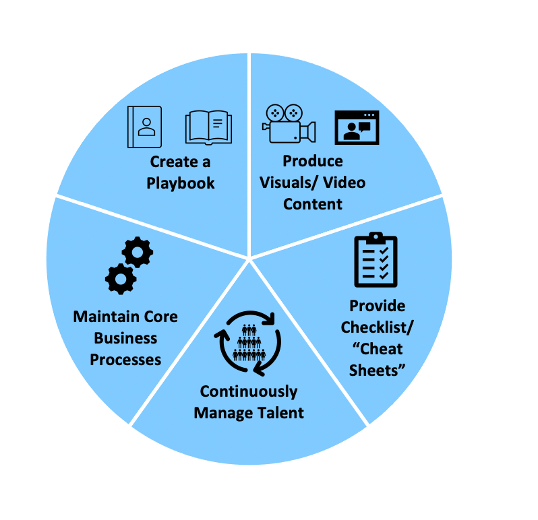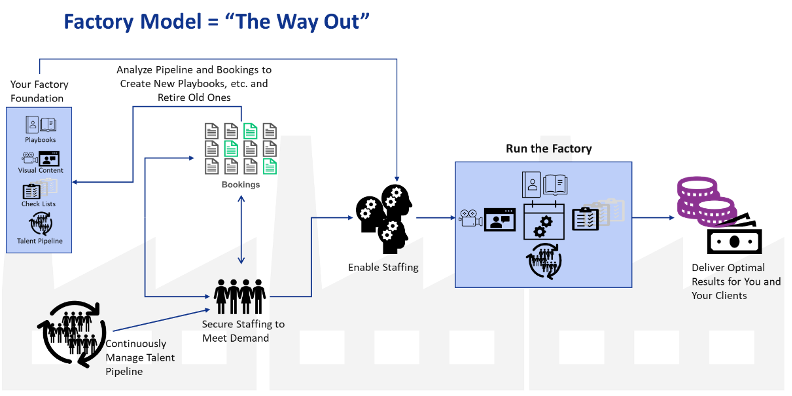As discussed in a previous blog (The PS Dilemma of Managing Just-In-Time Talent), leveraging a Just-In-Time (JIT) Professional Services (PS) Talent staffing without having a corresponding operating model can lead to increased risk to both delivery excellence and financial performance.
Smoothing the natural peaks and valleys of a JIT model is key and many manufacturing organizations have accomplished this via their manufacturing/assembly facilities – i.e., their Factory, which is defined as a person, group, or institution that continually produces a great quantity of something specified in a predictable and efficient manner.
Overcoming the Dilemma – A Factory Model as “The Way Out”
Therefore, we believe the best way to reduce the JIT PS Talent model risks is by leveraging a “factory” model. Factory success requires defined standards, tools, methods and processes, and your JIT PS Talent Factory model will include:
- Organizing and documenting Service Offers into Playbooks to provide a clear plan for how the delivery teams will operate, stay focused, be organized and accountable and get things done
- Making visual/video content available on-demand to enable JIT delivery resources to obtain key project delivery refreshers
- Providing checklists, “cheat sheets” and other simple reminders that are easily accessed and leveraged
- Continuously managing a Talent Pipeline while forecasting customer demand
- Core business processes and infrastructure to enable and support the model: e.g., Professional Services Automation application, project management, COVID requirements, pricing/cost models, direct vs. 3rd party, standard contracts/Statements of Work, etc.

Lastly, the model and all the operating components should be configurable so you can adjust and ensure optimized and repeatable results for you and your clients. The visual below depicts a summary of these elements working together:

In summary, a Factory with playbooks, visual content and standard checklists make it easier to manage a dynamic JIT PS Talent staffing model on a repeatable basis by:
- Defining roles, responsibilities, and decision rights of the Book-to-Bill business process
- Pre-defining the repeatable and known installation/implementation “plays” to allow your core key experts to focus on 1) the unique client situational exceptions rather than training newly formed teams on every activity and task on a project plan and 2) client management
- Having clearly defined talent needs for each step
- Onboarding contracted SMEs more efficiently
Results include:
- Improved financial performance
- Time to revenue for both your organization and your clients
- Improve margins
- De-risked delivery: Start at getting involved early with sales and account teams – true PS value is the execution piece and anything PS can do to shape deals and educate sellers is ideal; frees up capacity and reduces non-billable time
- Freed up leadership time to work on the business rather than in the business – e.g., define and plan for aspirational goals of the PS business
- The potential to create new lines of business and revenue streams (e.g., staff augmentation, PS-as-a-Service) by leveraging the foundational investment of having a “more ready and available” bench
In our next and final blog on this topic, we will provide a Factory construct example and an approach to take to apply this to your business.
Written by: Mark Slotnik
About the Author:
Mark Slotnik has spent nearly 20+ years advising clients in the areas of designing and taking to market high-value business solutions, solution portfolio management, talent development, resource management, business process re-engineering and commercial software.
